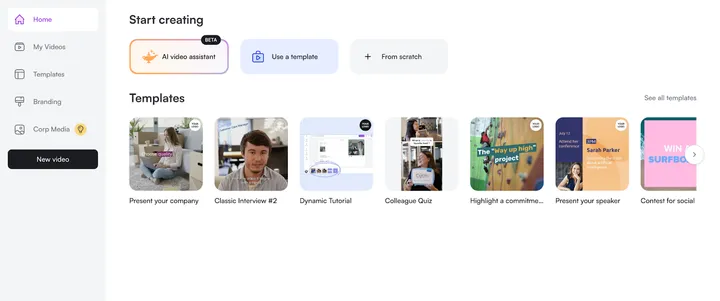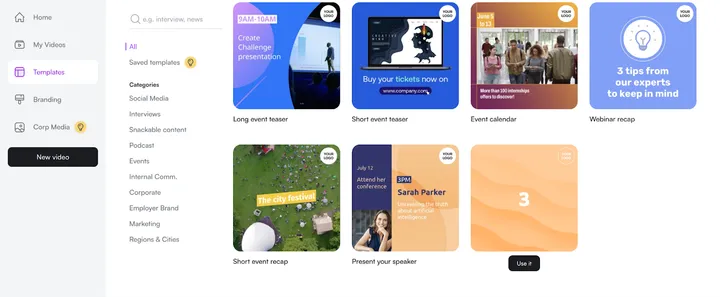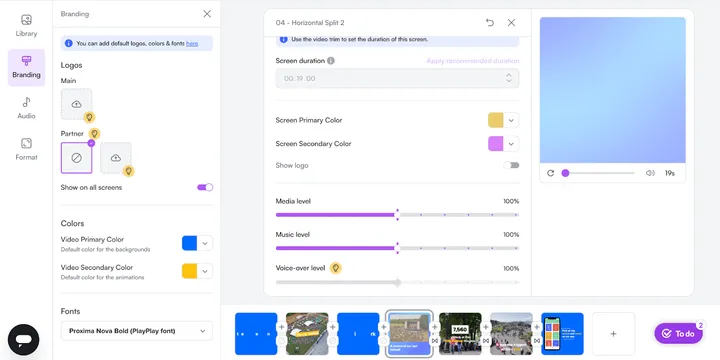You're a new brand in a highly competitive space. Your rivals are well-established industry giants with huge budgets and a lion's share of the market.
How do you measure up to them?
To succeed, you need a cost-effective yet potent marketing strategy that consistently puts you in front of your target audience, piques their interest, and eventually translates into market share.
That’s what brand awareness videos are for.
What is brand awareness?
Brand awareness is how well people, especially your target audience, recognize and remember your brand.
It starts with the obvious things like how easily they identify your logo, colors, product packaging, brand name, and other visual elements — but it doesn’t end there.
Some brands get so popular that they become household names for entire product categories — this is called brand genericization. A good example is how people use “Google” to refer to every and anything search and “Band-Aid” for adhesive bandages.
It takes time to reach this level of awareness, but incorporating video into your branding strategy can help you achieve this goal faster.
Why use video for brand awareness?
About 95% of marketers in Wyzowl’s 2023 State of Video Marketing report said that videos have helped them increase brand awareness. Video works well for brand awareness because:
- It’s easy to share: Video is the most shareable type of online content. More than 50% of people who watch a video will likely share it with someone in their network — making it the most effective way to get your brand in front of new people.
- It’s memorable: People are more likely to recall visual information — like images and colors — than bland text.
- It’s engaging: Video conveys information, emotions, and brand messages through a combination of visuals, audio and text — engaging multiple senses simultaneously.
Five tips for increasing brand awareness with video
Driving brand awareness with video doesn’t happen by chance. You need to intentionally bake brand visibility elements into your brand content to stand out and attract the right attention.
1. Use consistent visual elements repeatedly
Visual elements — like your logo and color schemes — are the easiest way for people to identify and remember your brand book.
For these elements to stick in your audience’s mind, you need two things:
- Consistency: Use brand guidelines to ensure that your logo, colors, and other visual elements are presented in the same way every time.
- Repetition: Always use brand visual elements in your videos. The more frequently people see them, the easier it gets to identify and associate these elements with your brand. Per the rule of seven, your audience needs to see your visual elements at least seven times to recall them.
“But I’m publishing a ton of videos! Customizing each one will slow me down.”
Yes. That’s why you need to automate the process. PlayPlay, for example, lets you create branded video templates with your logo, colors, fonts and everything else matching your unique style. Simply use the templates to customize and publish new videos quickly.
2. Limit “salesy-ness”
Nearly 90% of respondents in an ORC survey said they skip online video ads. Turning all your videos into aggressive sales pitches is the fastest way to lose your audience.
This doesn’t mean you shouldn’t talk about your product. You can and should: “86% of people say watching a video has convinced them to buy a new product.”
So what gives? Prioritize audience education over salesy content. Create exciting videos that show how your product solves specific problems and educate them about your brand. This is how you pique their interest and convert them into customers.
3. Tell compelling stories
Brand storytelling is how you build deep and lasting connections with your audience. Your videos should evoke emotions — whether it's humor, empathy, inspiration, or excitement — and reinforce your brand’s mission and values.
For example, much of the success of Coca-Cola’s “Share-a-Coke” campaign resulted from compelling storytelling. Through nostalgic narratives, the campaign showed people how sharing a Coke can help them connect with friends and family and create special shared moments.
A compelling story must go hand in hand with a great use of visual elements - Check out these examples of best brand videos to inspire you into making yours !
4. Distribute your videos
Don’t call it a day after publishing your video on one platform. Instead, reshare it on other platforms where your audience hangs out.
Tailor your branded video content to fit the platform where you plan to share it. For example, bite-sized videos do well on Instagram and TikTok, while YouTube prefers longer, in-depth content.
Say you posted a vlog on YouTube; break it into bite-sized videos and publish them on LinkedIn, TikTok, and X (Twitter). That’s how to get more eyes on your content and brand.
5. Encourage people to engage with your videos
Social media platforms reward content engagement. The TikTok algorithm, for instance, uses engagement rate to measure content quality and boost reach. So, the more people like, share, and comment on your videos, the more views you get.
If you want people to engage with your content, engage with theirs first. Amplify their videos, and they’ll return the favor happily. Also, ask questions in your videos, run contests, or provide incentives to get your audience involved.
Five brand awareness video ideas and examples
Now that you know how videos can level up your branding efforts, let's look at five types of videos you can include in your brand awareness strategy.
1. Employer branding videos
Employer branding videos position your company as a great place to work and help you attract A+ talent. But they are also a powerful tool for raising brand awareness — even when you aren't recruiting.
You can use employer branding videos to showcase your visual elements repeatedly for brand recognition. PlayPlay’s quarterly recap videos, for example, always include our logo, brand name, colors, and even product references to make it easy for our audience (and anyone really) to recognize and remember us.
Employer branding videos are also pretty valuable for rebranding campaigns — when introducing a new name or tagline to the market. In this case we talk about brand launch videos.
Take Meta, for example. When the company rebranded from Facebook to Meta in 2021, it put out this video to explain the reason for the name change and introduce its new logo and vision. The rebranding video and other publicity efforts helped Meta’s audience adjust to the brand change in no time.

Attract, retain and maximize ROI with employer branding
In this article, you will find everything you need to help you create a strong employer brand strategy that guarantees ROI.
Read now.
2. User-generated video content (UGC)
User-generated videos are the videos your audience creates and shares about your brand. In other words, they tell your brand’s story from the audience’s point of view.
Sometimes, you collaborate with niche influencers to produce them — like Sony did with travel influencer and YouTuber, Alma Asinobi. In other instances, a client or customer independently documents their experience with your brand and shares it with the people in their network — just like this Instagram beauty creator did.
Whatever the case, user-generated video content puts your brand in front of a new audience. Say a creator with 10,000 followers shares a video about your brand; that's potentially 10,000 new people learning about you. These people might become customers or recommend your product or services to others in their network.
This is also the opportunity to humanize your brand as UGC resonates more within viewers. In that sense, users' stories are highly effective in telling your audience how your product improved their lifes. This is your call to make a video interview which focuses on your customers' feedbacks and highlights the validation of your product.
Authenticity is key if you partner with influencers for UGC video creation. Remember, people want to see the creator’s first-hand experience with your brand, not a salesy promotional video. If you don't have the budget for influencer partnerships, you can:
- Create a branded hashtag and encourage your customers to share UGC videos with it. For example, Wayfair asks customers to share pictures of their purchases with #wayfairfinds.
- Organize a UGC video competition or giveaway like the GinoMax Christmas Challenge.
3. Product videos
Product videos highlight the features and benefits of your product. A good example is this video introducing PlayPlay’s AI video assistant. It's a two-minute walkthrough video where our CEO explains how the new product fits into PlayPlay's vision before doing a quick demo to show how it works. Buffer’s video announcing its new Notes feature is another inspiring example.
Most businesses use product videos as sales and customer success collateral for attracting and retaining customers. But, when these videos aren't generating leads or expanding customer accounts, they can increase your brand's share of voice. Share of Voice is the number of people who know and talk about your brand.
Let's say you share a video tutorial on how your product solves a particular problem. People searching for that solution might watch the tutorial and learn about your brand. They might sign up for your product immediately, but those who are not ready to buy have already discovered your brand. They can help you spread the word by sharing the video with their audience or mentioning your brand in industry conversations.
For example, our AI assistant video had more than 300 views on YouTube and more than 100 likes on LinkedIn. Some of these people who engaged with the video might have learned about our brand for the first time.
If you share product videos on social platforms like LinkedIn and YouTube, their algorithms can amplify them, helping you reach more people. For example, TikTok curates “For You” pages based on users' interests, allowing them to discover new and relevant content.

Want to explore further into branded product video creation?
4. Vlogs
A vlog is a narrative video documenting the creator's authentic experiences. It is particularly effective for brand awareness because it piggybacks on your employees’ influence and online following to help you reach new people.
For example, an employee who takes over your brand's social account for a day will likely ask people in their network to tune in. Individuals typically have more social media following than a brand — meaning you get more eyes on your content.
So, what type of vlogs can you create? “A Day in My Life video” is the first choice for most brands because it showcases the company culture in an authentic and exciting way.
Basically, your employee gives the audience an unfiltered look at their typical workday — from preparing for work to tasks and meetings at the office and their after-work routine.
They can pre-record the video, so the company uploads it to their social media accounts — like Oktopost does. Or take over your social accounts for a specific period (like we mentioned earlier) to share their experiences with the audience in real-time. Kuno Creative, for example, let employees take over its Instagram account and gained 450 followers in three months.
Event teasers and promotion videos also raise brand awareness because they are widely distributed.
When you post these videos to your social channels, prospective event attendees and your employees amplify them. They like and comment on the posts, which boosts the videos’ visibility. Some might repost the videos on their feed or use them to create new content.
PlayPlay's Content Summit is a great example here. We shared a promotional video on our brand accounts to create excitement for our event. Attendees, speakers and our employees created new content with these videos and shared them on their personal pages too. Also, people reposted content from our accounts directly, helping us reach a wider audience.
Learn from marketing leaders in LinkedIn, MarketingProfs, Booking.com at the Content Summit
On December 7th, Content Summit will bring together 10+ of the sharpest marketing and communication minds to share actionable insights to revolutionize your 2024 marketing strategy, tactics and ROI. 100% virtual. 100% free.
Save your seat How to create brand awareness videos with PlayPlay
PlayPlay lets you create engaging and professional brand awareness videos in less than 10 minutes. This tutorial assumes that you’ve already recorded your video.
Let’s dig in:
Step 1: Sign up for a free PlayPlay account.
Step 2: Select how you want to create the video. You can choose a template, try the AI video assistant, or do it from scratch. For this tutorial, we'll use a template.
Step 3: Choose your preferred template. We’ll use the short event recap template. Selecting the template takes you to the video editor.
Step 4: Click “upload media” to import your recorded video into your project dashboard.
Step 5: Edit the video elements. You can change text and color, add new screens, crop your video, and insert clips into different parts of the template. For example, we changed the template’s primary colors.
Step 6: Add your brand elements like logo, color, and typography to the video. You can save and use them repeatedly.
Step 7: Click “Preview” at the top right corner of your screen to see what your video looks like.
Step 8: If you’re satisfied with the look and feel, click “Generate HD video” at the bottom right corner of your screen to create a high-definition quality video. This will take a few minutes.
Step 9: That’s it! Your video is ready. Share it with your team for review, use the share link to share it with your audience, or download and upload it to your communication channels in a few clicks.
How to measure the success of your brand awareness videos
It’s hard to measure brand awareness because it’s intangible. Your best bet is to track your videos’ performance metrics — including shares, number of views, and likes — and use them to gauge your brand reach and visibility.
For example, a consistent increase in post engagements shows that your videos reach and resonate with a wider audience. These metrics will show up in the social platform's analytics.
You should also track your social mentions with tools like Brandwatch. If more people are talking positively about your brand online, then you’re doing something right.
Ready to scale your brand awareness with video?
Now that you know how effective videos are for brand awareness, it’s time to try things out for yourself. And the best part is you don’t need any technical skills to pull this off. You can create and launch an exciting brand introduction video in minutes with PlayPlay.
With our wide range of templates and drag-and-drop features, it's never been easier to create professional-looking videos. Try it today and start scaling your brand!
Try PlayPlay for free!
Melissa Francois
Head of Global Content & Comms
With over 10 years of experience in the wild world of SaaS, Melissa cares about building great brand stories and driving community engagement through engaging content. Off the clock, she enjoys long walks and a pint in a cozy country pub.






